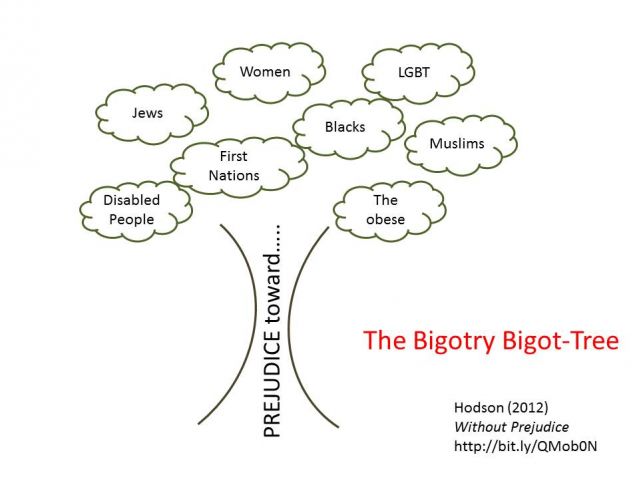
Bias
Generalized Prejudice: The Bigotry Bigot-Tree
Disliking one outgroup (gays) associated with disliking others (Asians)
Posted August 10, 2012
This past Sunday Wade Michael Page went on a shooting rampage at a Sikh temple in Wisconsin, killing six people and wounding three others (link; link). Understanding the reasons why such mass killings occur represents a complicated task. Some answers are clearly political in nature, others philosophical, and other scientific. As a social psychologist I am aware of no simple (or pat) answers capable of explaining such events. The question is made all the more complicated, of course, when the perpetrator attacks an outgroup (i.e., group to which he or she does not belong). This clearly adds a social (even intergroup) element to the equation. So are such findings entirely explained by the social context?
Something about this story caught my eye as a prejudice researcher (see article in the Guardian, link). Page apparently had served in the US military, as a member of Psychological Operations. One of his former colleagues in the unit indicated that Page took offense to the colleague dating Latina women (calling him a “race traitor”), consistent with Page’s general reference to racial outgroups as “dirt people.” According to this colleague “It didn’t matter if they were black, Indian, Native American, Latin—he hated them all.”
In the prejudice field we refer to such a tendency as generalized prejudice. Relative to other people, some individuals show a strong dislike of multiple outgroups. Altemeyer (1996, p.26) rather cheekily refers to such people as “equal-opportunity bigots.” Visually, I’ve represented this effect in terms of the Bigotry Bigot-Tree (see Figure). [note: be sure to scroll down after figure to read subsequent text; some browsers leave a large gap]

A visual representation of correlated prejudices
Some examples might prove illustrative: Hitler clearly characterizes an individual prejudiced toward a range of outgroups, whereas Ghandi characterizes an individual widely tolerant toward a range of outgroups. This stable difference between people represents a very robust finding in the research literature. We even find evidence of such proclivities at the implicit level of attitudes; that is, on reaction time measures where people pair social groups with positively or negatively valenced responses (e.g., words like peace or death), we similarly find that people disliking one group (e.g., the poor) also dislike other groups (e.g., Jews) (see Bergh et al., in press; Cunningham et al., 2004). There is even evidence that generalized biases have a heritable basis (Lewis & Bates, 2010).
Why is this finding of generalized prejudice of particular interest? For the simple reason that it tells us a great deal about the nature of prejudice. To some extent, expressions of prejudice find their roots or origins within people, as part of their psychology. If you find this an obvious conclusion, you would likely be surprised to learn that the psychological prejudice field engages in heated debates over whether the causes of prejudice are rooted in the person or the situation/context (Hodson, 2009; Hodson et al., in press). To be clear, the research record most clearly supports the view that prejudices are the result of personal factors, situational factors, and their interactive effects. We ignore the effects of the person at our peril, just as we ignore the situational effects at our peril.
As a prejudice researcher, I find this generalized prejudice finding both fascinating and disturbing. To be clear, evidence of generalized prejudice does NOT mean is that prejudice is fixed, immutable, or inevitable. In fact, there exists a large body of research demonstrating that prejudices are malleable and manageable. Even extremely prejudiced people can become very tolerant (or, at minimum, learn to suppress and inhibit their biases). People in war-torn regions can become fast friends after decades of conflict (consider the tight bonds between the US and Japan, or France and Germany, widely deemed impossible after WWII).
Ultimately, prejudice is a multi-faceted and complex social phenomenon, with roots that are intrapsychic (i.e., within people) and caused by external forces. Pointing a finger at any one particular cause, to the exclusion of others, is short-sighted and not supported by the empirical literature.
Readings:
Altemeyer, B. (1996). The authoritarian specter. Cambridge, MA: Harvard University Press.
Bergh, R., Akrami, N., & Ekehammar, B. (in press). The personality underpinnings of explicit and implicit generalized prejudice. Social Psychological and Personality Science.
Cunningham, W.A., Nezlek, J.B., & Banaji, M.R. (2004). Implicit and explicit ethnocentrism: Revisiting the ideologies of prejudice. Personality and Social Psychology Bulletin, 30, 1332-1346.
Hodson, G. (2009). The puzzling person-situation schism in prejudice research. Journal of Research in Personality, 43, 247-248.
Hodson, G., Costello, K., & MacInnis, C.C. (in press). Is intergroup contact beneficial among intolerant people? Exploring individual differences in the benefits of contact on attitudes. In G. Hodson & M. Hewstone (Eds.), Advances in intergroup contact. London, UK: Psychology Press.
Lewis, G.J., & Bates, T.C. (2010). Genetic evidence for multiple biological mechanisms underlying in-group favoritism. Psychological Science, 21, 1623-1628.



